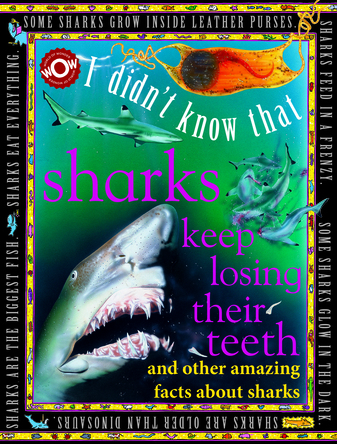Extrait du livre I Didn't Know That Sharks Keep losing Their Teeth
Get ready to hear your kids say, “Wow! I didn’t know that!” as they dive into this fun, informative, question-answering series of books! Students—and teachers and parents—will learn things about the world around them that they never knew before! This approach to education seeks to promote an interest in learning by answering questions kids have always wondered about. When books answer questions that kids already want to know the answers to, kids love to read those books, fostering a love for reading and learning, the true keys to lifelong education. Colorful graphics are labeled and explained to connect with visual learners, while in-depth explanations of each subject will connect with those who prefer reading or listening as their learning style. This educational series makes learning fun through many levels of interaction. The in-depth information combined with fantastic illustrations promote learning and retention, while question and answer boxes reinforce the subject matter to promote higher order thinking. Teachers and parents love this series because it engages young people, sparking an interest and desire in learning. It doesn’t feel like work to learn about a new subject with books this interactive and interesting. This set of books will be an addition to your home or classroom library that everyone will enjoy. And, before you know it, you, too, will be saying, “Wow! I didn’t know that!” “People cannot learn by having information pressed into their brains. Knowledge has to be sucked into the brain, not pushed in. First, one must create a state of mind that craves knowledge, interest, and wonder. You can teach only by creating an urge to know.” - Victor Weisskopf
Introduction Did you know that some sharks are older than dinosaurs? That most sharks are smaller than you? That some grow inside mermaid purses? Discover for yourself amazing facts about sharks, like how big the whale shark is and how tiny the dwarf shark is. Find out what they eat, how they have babies, who their enemies are, and more. Watch for this symbol, which means there is a fun project for you to try. True or False? Watch for this symbol and try to answer the question before reading on for the answer. ! Don’t forget to check the borders for extra amazing facts.
! Megalodon was as long as two buses parked end-to-end. I didn't know that : Sharks are older than dinosaurs. Sharks’ ancestors lived about 200 million years before dinosaurs. Some were giants and had spines on their head. Can you find five trilobites? Just a few sharks turned into fossils, but many of their teeth did! This tooth (left) measures almost 5 inches(12 centimeters) long, and belonged to a monster shark called “megalodon.” A great white shark’s tooth is half this size. Cladoselache lived about 350 million years ago, and measured about 6.5 feet (2 meters) from teeth to tail. The shark’s mouth was at the tip of its snout, not tucked underneath like most sharks today. This fossil of a shark called “stethacanthus” shows that it had thorny spines. Fossils of sharks are rare because their skeletons are made not of bone, but cartilage, which rots away before it can fossilize. ! Port Jackson sharks still have spines, just like their ancestors did.
! In winter, basking sharks hibernate on the seabed. I didn't know that : Sharks are the biggest fish. The whale shark measures up to 42 feet (13 meters) long, and is the largest fish in the sea. This gentle giant feeds peacefully, filtering tiny plants and animals from the water. The dwarf shark is just 6 inches (15 centimeters) long, not much bigger than a goldfish. In fact, half of all known sharks measure less than 3 feet (1 meter) long. Can you find three divers? To see how big a whale shark really is, try making one in the park or on the beach. Using a yardstick (or meterstick) as a guide, measure out its length, then fill in the outline with pebbles or twigs. The basking shark is the world’s second largest fish. It swims with its mouth open to catch microscopic sea creatures. ! Whale sharks are so gentle that divers can ride on them.
! Cookie-cutter sharks glow green for three hours after they’re caught. I didn't know that : Some sharks glow in the dark. Some sharks that live in the deep, dark parts of the ocean make their own light. The jaws of a megamouth shark give out a silvery glow. This probably helps attract tasty shrimp. Can you find six jellyfish? The goblin shark (above) lives at the bottom of the sea. Its long, sensitive snout helps it find any nearby prey. Lantern sharks (left) glow in the water, thanks to a shiny slime on their skin. Experts think the coloring may help sharks attract their prey or keep their place in a shoal. The cookie-cutter shark gets its name from its curious bite. When the shark attacks another animal, it leaves a wound that is perfectly round—just like a cookie. ! The frilled shark had elongated eyes to see in the murky depths.



























